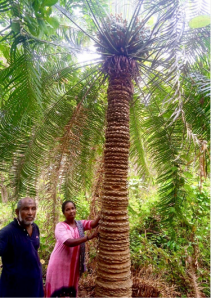ForumIAS announcing GS Foundation Program for UPSC CSE 2025-26 from 19 April. Click Here for more information.
ForumIAS Answer Writing Focus Group (AWFG) for Mains 2024 commencing from 24th June 2024. The Entrance Test for the program will be held on 28th April 2024 at 9 AM. To know more about the program visit: https://forumias.com/blog/awfg2024
Source-This post on Cycas circinalis (Eenthu Pana) is based on the article “Rare tree fights a losing battle in north Kerala” published in “The Hindu” on 3rd March 2024.
Why in the News?
Cycas circinalis (Eenthu Pana) faces the threat of extinction in northern Kerala due to an unidentified and rapidly spreading plant disease.
About Cycas circinalis

1. About-Cycas circinalis, also known as Queen Sago, is a species of cycad native to southern India and Sri Lanka.
2. Classification:
a. It is classified within the cycads family (Cycadaceae), which ranks among the planet’s most threatened plant groups.
b. These plants originated 300 million years ago during the Carboniferous period, making cycads the oldest surviving group of seed plants.
3. Recognized by names in India-It is called Eenthu Pana in Kerala and has various names like Mund isalu (Kannada), madana kama raja (Tamil), and Malabari supari (Marathi) in different states.
4. Characteristics:
a. It is an evergreen tree resembling a palm, reaching heights of up to 25 feet.
b. It is commonly found in dense, scrubby woodlands in hilly regions that experience seasonal dryness.
c. During extremely arid periods, it may shed its leaves.
d. It requires complete dryness for processing, which is challenging since it is usually harvested during the rainy season.
e. Typically, it takes 40 to 50 years for the trees to bear fruit.
5. Geographical distribution:
a. It is recognized as an Indian native plant, found exclusively in the Western Ghats region, spanning the states of Kerala, Karnataka, Tamil Nadu, and southern Maharashtra.
b. Among the nine cycad species identified in India, six are native to the country.
6. Applications– It is a valuable plant used for nutrition by many local communities in the Western Ghats.
UPSC Syllabus- Environment (Species in news)





